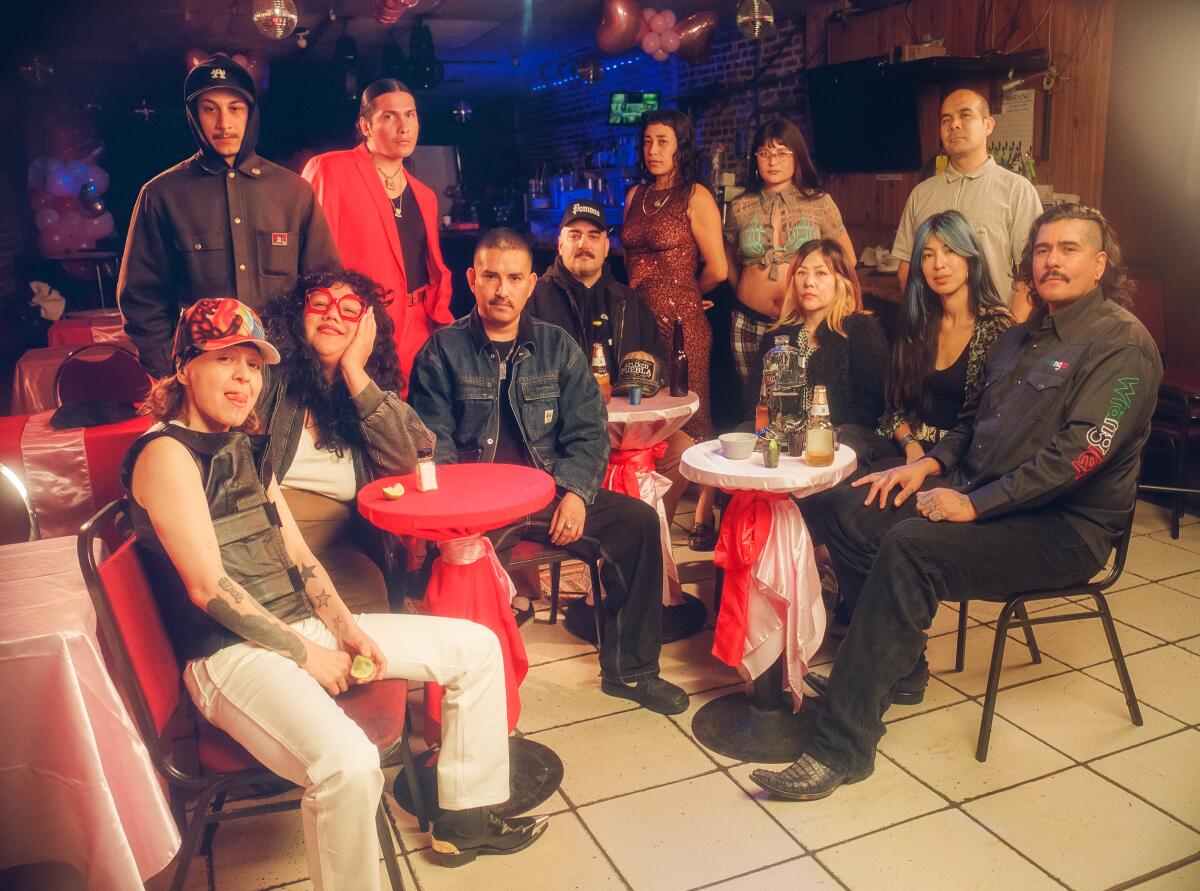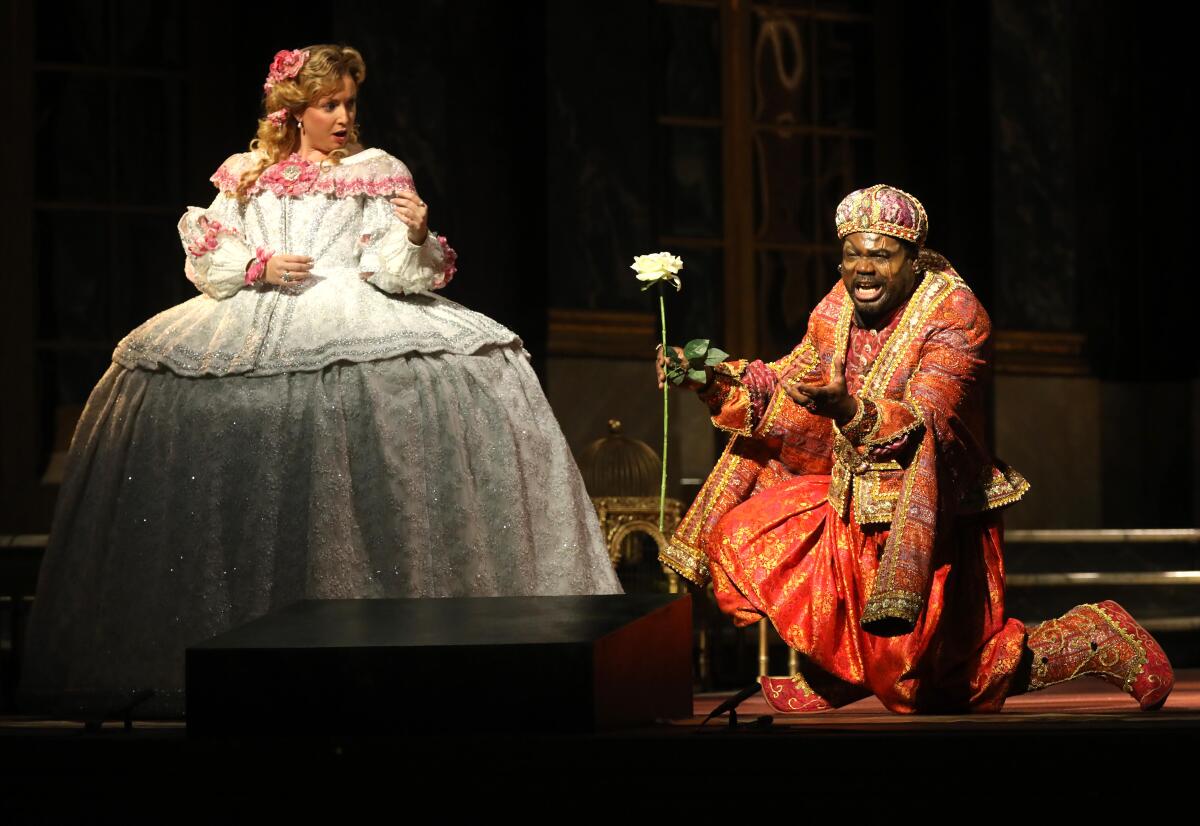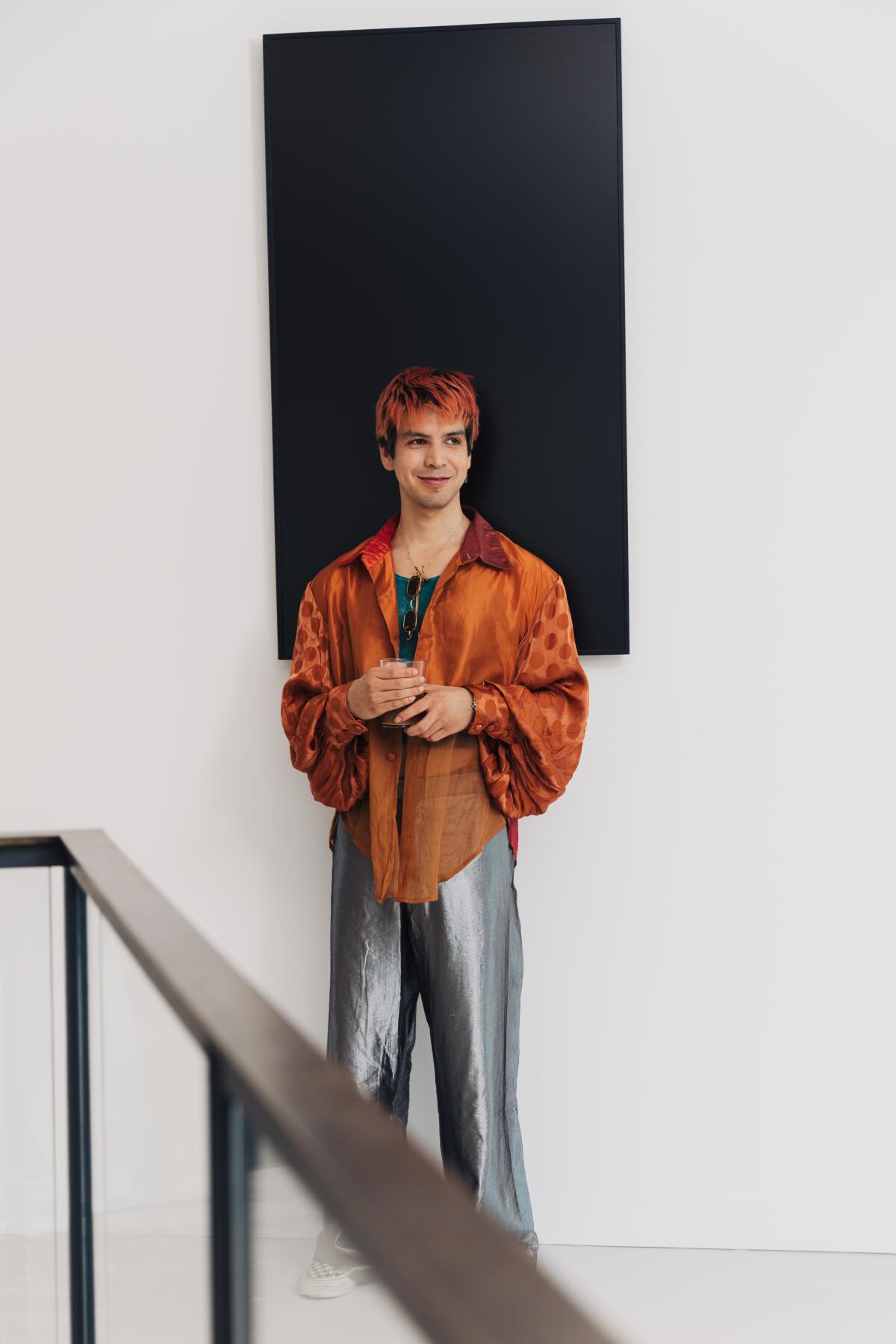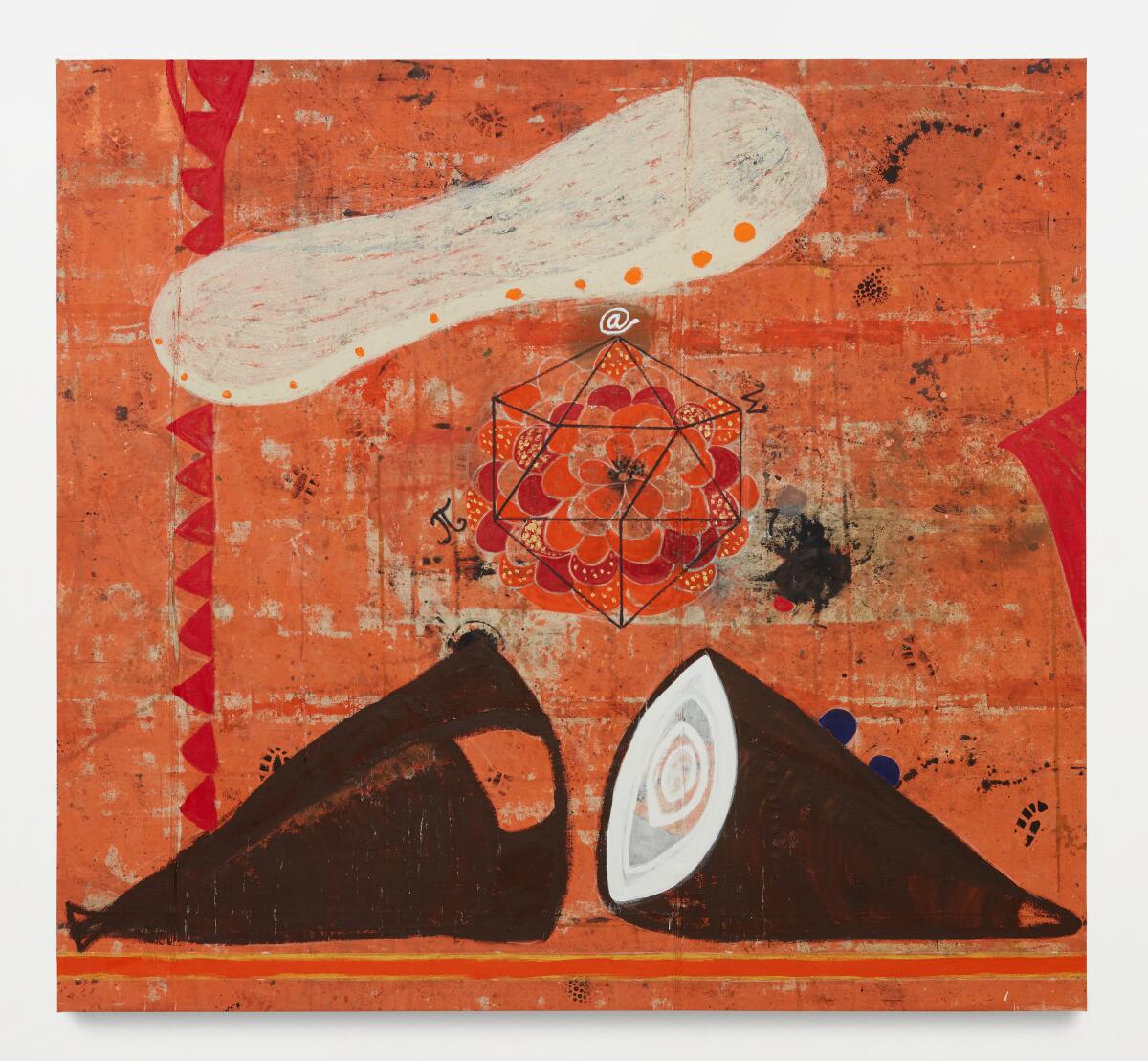New York Review of Architecture goes West with special issue devoted to L.A.

- Share via
In these trying, rainy times, I’ve been eating all the comfort foods, but I have developed special reverence for the oyster and mushroom porridge at Bonjuk on Western. (Also, the rooftop location is tops.) I’m Carolina A. Miranda, art and design columnist at the Los Angeles Times, and I’m here with all the warm carbs and essential arts news.
Kick a building
Criticism is in crisis. Architecture criticism, perhaps, more than most. You can count the architecture critics with staff jobs with one hand. Namely, Michael Kimmelman at the New York Times, Mark Lamster at the Dallas Morning News and Justin Davidson at New York Magazine (who also writes about music). The Los Angeles Times has not had a staff critic since Christopher Hawthorne departed in 2018 (though his byline does now occasionally materialize in the New York Times and the New Yorker). Neither, for that matter, does the Chicago Tribune, which lost Blair Kamin in 2021 and never replaced him. This, in Chicago, a city renowned for its architecture — and one that hosts a biennial on the subject.
Other important critics regularly materialize in other publications — such as Alexandra Lange at Bloomberg, Martin Filler at the New York Review of Books, Kate Wagner at the Nation and the Guardian‘s Oliver Wainwright, who is based in London but regularly pops over to the U.S. for reporting assignments. And while my focus is art, I also regularly dip into the subject. (Somebody had to cover the Las Vegas Sphere and that Tom Wiscombe billboard thingie.) But, as a general rule, a profession that inhales a lot of money, a lot of land and a lot of material generally goes wildly underscrutinized and uncritiqued — especially in any place that is not New York.
Which is why I was happy to see that upstart architecture magazine the New York Review of Architecture (founded in 2019) devoted its entire March issue to L.A.

Published as the Los Angeles Review of Architecture, the special issue was guest edited by Mimi Zeiger, an L.A.-based critic and curator who has contributed regularly to The Times, as well as publications such as the Architectural Review and Metropolis, in collaboration with Samuel Medina, who serves as the publication’s top editor.
The issue contains a lively mix of stories. Alissa Walker, who for many years wrote for Curbed (and also has written for The Times), has a look at the urban dynamics of the shoe-shaped Lucas Museum, with a fascinating dive into Eric Garcetti‘s official mayoral portrait. And Claudia Ross has an intriguing story about how density is coming for Hollywood Forever Cemetery — in the form of a vertical mausoleum designed by Lehrer Architects. “A tomb,” she states dryly, “may be the most stable housing in Los Angeles.”
You’re reading Essential Arts
Our critics and reporters guide you through events and happenings of L.A.
You may occasionally receive promotional content from the Los Angeles Times.
Also in the mix is a look at how Disney‘s proposed residential community in Rancho Mirage pretty much bulldozes some of the real architectural and landscape design advances being made in the desert, as well as “the aura of disarray” that marks planning for the L.A. Olympics in 2028. (Not to mention the disarray around our stadiums, very few of which sync with mass transit.)
Los Angeles is a very big, very atomized space with a lot of burning urban issues. And these cannot be adequately covered by a single staff critic (even if we had one). So the diversity of stories and voices in the Los Angeles Review of Architecture is welcome. Here’s hoping this becomes an annual venture.
Find the special issue and how to subscribe at nyra.nyc/lara.
In and out of the galleries
A “modest but illuminating survey” of the works of Sargent Claude Johnson is on view at the Huntington Library, Art Museum and Botanical Garden, writes Christopher Knight. The artist, who was born in Boston and later settled in the Bay Area, was one of the more distinctive visual artists associated with the Harlem Renaissance. The show brings together works from throughout his life and pieces that have been scattered across collections. “One centerpiece, the decorative multipart organ screen that is in the Huntington’s collection,” writes Knight, “has been reunited with other components for the first time in more than four decades.”

Galleries in laundry rooms, backyard cabins and converted garages. Contributor Mariella Rudi has a piece on the DIY spaces used for exhibitions around L.A. “Everybody eats, everybody drinks, everybody’s invited,” said Jay Ezra Nayssan, who runs Del Vaz Projects out of his Santa Monica home with his partner, Max Goldstein. “We don’t operate in this realm of exclusivity and scarcity.”
At Jeffrey Deitch, the group show “At the Edge of the Sun” brings together Los Angeles artists Maria Maea, Guadalupe Rosales, Alfonso Gonzalez Jr. and Shizu Saldamando, among others — who do not need to be brought together. They organized the show themselves. “It feels pretty major for us to just take up this space,” says artist rafa esparza. Image magazine’s Julissa James talks to the group about their process and their connection to one another.

For more than a year, questions have swirled about what would happen to the historic hilltop campus of the San Francisco Art Institute (which went bankrupt), along with its incredible Diego Rivera mural. Well, it appears there is good news: The campus has been acquired by a newly formed nonprofit established by Laurene Powell Jobs with the intention of using it as an arts institution. Laura Waxman at the SF Chronicle has the deets.
Travis Diehl profiles artist Paul Pfeiffer — currently the subject of a retrospective at MOCA — in the New York Times.
Classical notes
L.A. Opera is staging a pair of short operas — Alexander Zemlinsky‘s “The Dwarf” and William Grant Still‘s “Highway 1, USA” — that may not appear to have anything in common: Zemlinksky was a European emigré who fled the Nazis; Still made a name for himself during the Harlem Renaissance. But Times classical music critic Mark Swed finds shared space. Both were composers, he writes, who held onto classical tradition “at a time when music in their worlds was progressing at a great rate.”

Plus, it’s Frank Gehry‘s 95th birthday — and Swed revisits all that it took to get Disney Hall built. “Disney opened as an instant icon,” he writes. “It catapulted the L.A. Phil to far greater fame than the orchestra had ever known.” But the concert hall, he writes, is ready for an update — and that would include implementing some of the ideas that the architect proposed years ago, such as an acoustically tuned orchestra pit.
Design time
Speaking of L.A. architecture, The Times’ Lisa Boone has a look at a home expansion designed by Formation Association, the Chinatown studio established by John K. Chan. The architect was able to add square footage, storage and natural light to a home on a tight triangular lot — while preserving an enormous olive tree that shades the home.
Enjoying this newsletter? Consider subscribing to the Los Angeles Times
Your support helps us deliver the news that matters most. Become a subscriber.
Vince Skelly is known for creating sculptures and furnishings that draw from wood’s natural forms. “Rather than function as austere showpieces,” writes contributor Jessica Ritz, “Skelly’s creations blend into this welcoming home environment full of earthy colors and personal treasures.”
Around the culture
It’s a story about the intersecting paths of a young Salvadoran immigrant in desperate need of a work visa and a combative art critic trying to burnish the legacy of her cryogenically frozen lover, an artist known for creating paintings of eggs. That is the plot of comedian Julio Torres’ absurd and unreal new feature film, “Problemista,” which opens in L.A. and New York this week. I chatted with Torres about the film — but also about working odd jobs, labor solidarity, a naughty saxophone and why art people can be so deranged.

An interesting tangent that did not make it into my final story: The look of bossy art critic Elizabeth (played by Tilda Swinton) was inspired, in part, by the work of surrealist Leonora Carrington. “I, along with our costume designer Catherine George, we were researching stuff and then we found this Leonora Carrington painting [known as] ‘The Guardian of the Egg,’” Torres told me. “And it just depicted an Elizabeth-like woman holding an egg. It was just, ‘Omigod, we’re really onto something here.’”
Elizabeth’s look — bold dresses and bright red hair — also could have been inspired by 20th century L.A. artist Cameron, whose undated canvas “The Black Egg” features a rather terrifying redhead bearing an egg. I’m just happy to know that witchy egg-bearers are getting their moment in pop culture.
Essential happenings
Contributor Alison Brower rounds up the essential art fair activity for Frieze Week.
But while Frieze costs money, galleries are free! Here’s what’s on my to-do list:
David Zwirner‘s new East Hollywood outpost is showing a selection of the “planks” and “columns” sculptures by John McCracken, a figure associated with the L.A. Cool School. They are on view through March 30.
In West Hollywood, keep an eye out for shows by painters Ouattara Watts and Luigi Zuccheri at Karma — both shows are up through March 16.

In WeHo, you’ll also find Pat Steir‘s first solo L.A. show in more than 30 years at Hauser & Wirth‘s Westside branch. You’ve got until May 4 to catch it.
Also in the neighborhood, you’ll find works from Valie Export‘s “Embodied” series at the MAK Center. The show closes April 7.
Over at Roberts Projects on La Brea, you’ll find a clutch of new works by Betye Saar as well as “Marilyn Nance: The Women of FESTAC’77,” which features photographs and archival materials from the Second World Black and African Festival of Arts and Culture — on view until April 27.
In Hauser’s downtown L.A. space, don’t miss “RETROaction (part two),” a group show that engages the legacies of “The Theater of Refusal,” a groundbreaking exhibition organized by artist Charles Gaines and Catherine Lord at UC Irvine 30 years ago. “RETROaction” will be on view through May 5.
I’m looking forward to seeing June Edmonds’ new series at Luis De Jesus Los Angeles in downtown. Titled “Meditations on African Resilience,” these abstract, pattern-filled works find inspiration in the emblem of a river leaf employed within the precolonial Kingdom of Benin, and will be on view through April 13.
Lastly, in addition to “At the Edge of the Sun,” mentioned above, Jeffrey Deitch also has a solo show by Mr. Wash in its secondary space, and it’s on view through March 30. (ICYMI: My colleague Deborah Vankin profiled Mr. Wash in 2021, when he was selected for the Hammer Museum’s “Made in L.A.” biennial.)

Plus, mark your calendars: March 23 is the SoCal Museums Free-for-All, when more than 30 institutions from Orange County to Santa Barbara will be free to the public.
Moves
Daisy Nam has been named the director and chief curator of the museum at the Wattis Institute for Contemporary Arts in San Francisco.
Tatiana Cuevas has been named director of UNAM’s Museo Universitario de Arte Contemporáneo in Mexico City. She replaces Amanda de la Garza, who is headed to the Museo Reina Sofía in Spain.
Paul M. Farber, director of Monument Lab, will join the Mellon Foundation‘s board of trustees.
Marilyn Jackson, currently the director and CEO of the Muhammad Ali Center in Louisville, Ky., has been named president of the American Alliance of Museums.
Jerald Cooper, known for his Instagram account Hood Midcentury Modern, which highlights Black Modernism, is the winner of the Julius Shulman Institute‘s excellence in photography award.
Passages
Camilla Chandler Frost, a Los Angeles philanthropist known for her support of educational causes and the arts (she began supporting LACMA as a docent in the 1950s), has died at the age of 98. Chandler was the daughter of Dorothy Buffum and Norman Chandler, scions of the Chandler family, who once owned The Times.
Richard Abath, a guard who unwittingly found himself at the center of an infamous 1990 heist at Boston’s Isabella Stewart Gardner Museum in 1990, is dead at 57.
Günter Brus, one of the artists who helped found Viennese Actionism, a radical movement known for employing the body and bodily fluids in visceral performances that cut through the “bourgeois civility of a country haunted by its Nazi past,” is dead at 85.
In the news
— How Kabul has changed the Taliban.
— Whoaaaaaaaaa that profile of Louise Blouin in the New York Times.
— ARTnews has a good interview with art crime professor Erin Thompson, whose writings about theft, forgery and repatriation I’ve linked to in the past.
— Sort of related: this article by Gary Baum in the Hollywood Reporter about contested ancient artworks from Asia held in LACMA’s collection.
— How much climate change can we attribute to rocketing Jeff Koons sculptures to the moon for a failed landing?
— Philadelphia’s Kimmel Center for the Performing Arts is renaming its main concert hall for pioneering Black contralto Marian Anderson.
— Digging Sam Sweet‘s latest “Questionnaire” interview with filmmaker Laurie Frank.
— Things I’m obsessing over: Chilean novelist José Donoso‘s diaries. I’m currently rereading “The Obscene Bird of Night” which is disorienting and completely twisted — and should be on everyone’s list after “Pedro Páramo.”
— Since we’re on the subject of Chile: Francine Prose writes about Pablo Larraín’s “El Conde,” which is also very twisted. (Chilenos truly are the Gothiest of Goths.)
— I give you permission to crush my mummified remains and turn them into pigment.
And last but not least ...
Two words: Reesa Teesa.
The biggest entertainment stories
Get our big stories about Hollywood, film, television, music, arts, culture and more right in your inbox as soon as they publish.
You may occasionally receive promotional content from the Los Angeles Times.




